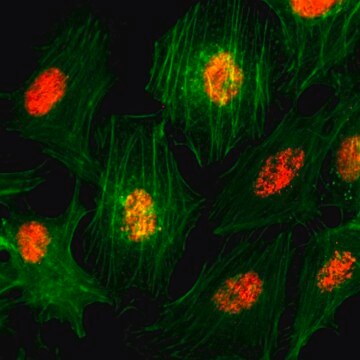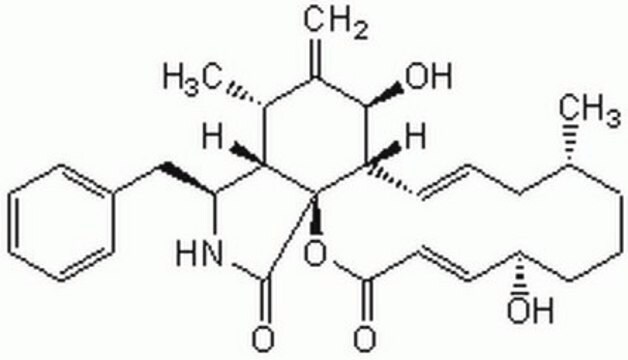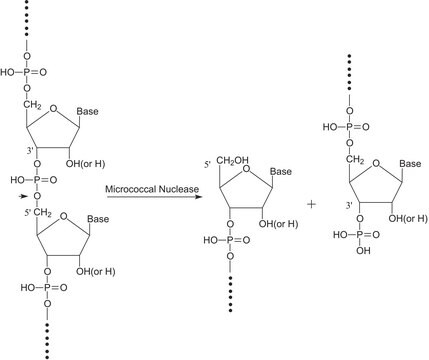General description
Histone H4 (UniProt P62805; also known as H4 histone family member A, Histone 1 H4a) is encoded by the HIST1H4A (also known as H4/A, H4FA) gene (Gene ID 8359) in human. Histone H4 is one of the main histone proteins that contribute to the chromatin structure in both prokaryotic and eukaryotic cells. Histone H4 can undergo several different types of epigenetic modifications that influence cellular processes, including methylation and acetylation on lysine and arginine residues, phosphorylation on serine and threonine residues, as well as conversion Arg3 to a citrulline residue by the peptidylarginine deiminase PAD4-catalyzed deimination reaction, also known as citrullination). Histone H4 Arg3 citrullination (H4Cit3) weakens histone-DNA interaction as a result of a conformational change and a reduced positive charge at the histone H4 N terminal end. Bacterial infection is known to stimulate H4Cit3 in neutrophils, forming highly decondensed extracellular chromatin structure NET (neutrophil extracellular trap) that could capture and kill microorganisms. On the other hand, citrullinated proteins are recognized as non-self proteins and subsequently activate immune systems. A functional haplotype of the PADI4 gene has been shown to be associated with the pathogenesis of rheumatoid arthritis through induction of the antigenicity of proteins. H4Cit3 is induced in response to DNA damage through the p53-PADI4 pathway, resulting in upregulated H4Cit3 immunoreactivity localized around fragmented nuclei in apoptotic cells. In addition, H4Cit3 level is negatively correlated with p53 protein expression and tumour size in non-small cell lung cancer (NSCLC) tissues, indicating a crucial role of H4Cit3 in carcinogenesis.
Specificity
Predicted to react with a broad range of species based on 100% sequence homology.
This rabbit polyclonal antibody detected PAD4-catalyzed Arg3 citrullination of recombinant histone H4 and H2A, as well as calcium ionophore-induced histone H4 Arg3 citrullination (H4Cit3) in HL-60 cells. Cellular PAD4 (peptidyl arginine deiminase 4) knockdown greatly diminished ionophor-induced H4Cit3, while antibody blocking with the immunogen peptide prevented target band detection (Tanikawa, C., et al. (2012). Nat. Commun. 3:676; Wang, Y., et al. (2004). Science. 306(5694):279-283).
Immunogen
Epitope: N-terminus
KLH-conjugated, synthetic peptide corresponding to amino acids 1-10 (SG[cit]GKGGKGL-C) of human histone H4 (Met1 removed), where [cit] denotes citrullinated Arg3. A C-terminal cysteine was added for conjugation purposes.
Application
Anti-Histone H4 (Citrulline 3) Antibody, Cat. No. 07-596, is a highly specific rabbit polyclonal antibody that targets histone H4 citrullination (H4Cit3) and has been tested in Chromatin Immunoprecipitation (ChIP), Immunocytochemistry, Immunohistochemistry, and Western Blotting.
Research Category
Epigenetics & Nuclear Function
Research Sub Category
Histones
Quality
Evaluated by Western Blotting in HL-60 cell lysate.
Western Blotting Analysis: A 1:1,000 dilution of this antibody detected differentiation-induced histone H4 Arg3 citrullination (H4Cit3) in 10 µg of lysate from calcium ionophore-treated HL-60 cells.
Target description
~12 kDa observed. 11.24/11.37 kDa (H4 with/without Met1 removal) calculated. Uncharacterized bands may be observed in some lysate(s).
Physical form
Affinity purified.
Purified rabbit polyclonal antibody in buffer containing 0.1 M Tris-Glycine (pH 7.4), 150 mM NaCl with 0.05% sodium azide.
Storage and Stability
Stable for 1 year at 2-8°C from date of receipt.
Other Notes
Concentration: Please refer to lot specific datasheet.
Legal Information
UPSTATE is a registered trademark of Merck KGaA, Darmstadt, Germany
Disclaimer
Unless otherwise stated in our catalog or other company documentation accompanying the product(s), our products are intended for research use only and are not to be used for any other purpose, which includes but is not limited to, unauthorized commercial uses, in vitro diagnostic uses, ex vivo or in vivo therapeutic uses or any type of consumption or application to humans or animals.











